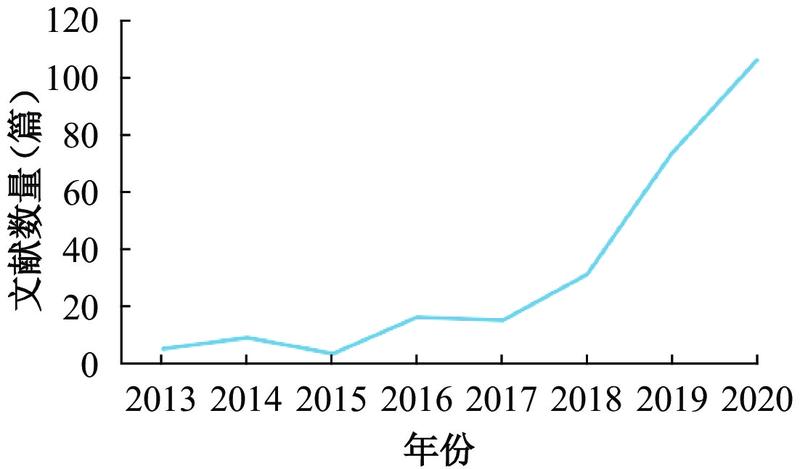网红经济视域下的影响者营销:研究述评与展望

吉林财经大学 管理科学与信息工程学院,吉林 长春 130117 收稿日期: 2020-08-13 基金项目: 国家社会科学基金项目(17CGL006) 作者简介: 贾微微(1982—),女,吉林财经大学管理科学与信息工程学院副教授,硕士生导师(通讯作者,[email protected]); 别永越(1997—),男,吉林财经大学管理科学与信息工程学院硕士研究生。
摘要:本文所说的影响者是指在社会化媒体平台上通过在线分享自己所创作的内容进行自我打造而出名的网络红人,如美食博主、美妆博主、网红主播等,他们建立了自己庞大的粉丝群,并将在线社交活动作为职业,具有巨大的影响力。这些社会化媒体影响者所提供的信息更容易快速抵达目标受众、更容易被病毒式传播,且往往不会被感知为纯粹受商业利益驱动,容易受到粉丝信任,因此他们天然具有营销优势。近年来,越来越多的企业开始通过这些影响者为其产品或服务背书,希望以此影响消费者的态度和决策,从而形成了影响者营销这种高效的新型营销手段。本文对影响者营销相关研究进行了综述,勾勒了影响者营销研究的发展脉络,分析了影响者营销的概念,介绍了影响者营销的应用领域,梳理了影响者营销作用机制的理论解释模型,并进一步提出了基于准社会关系的整合性研究框架,以期为影响者营销的研究者和实践者提供思路与参考。
关键词:网红;社会化媒体影响者;主播;影响者营销;准社会关系
Influencer Marketing from the Perspective of Internet Celebrity Economy: A Literature Review and Prospects

School of Management Science and Information Engineering, Jilin University of Finance and Economics, Changchun 130117, China
Summary: With the rise of internet celebrity economy and the rapid development of diversified social media platforms, influencer marketing, as a new and efficient marketing strategy, has triggered a marketing revolution. The influencers mentioned in this article refer to internet celebrities who are famous for self-building by sharing creations on social media platforms, such as food bloggers, beauty bloggers, and social media streamers. They establish a huge fan base and regard online social activities as a profession, which have a huge influence. The information provided by these social media influencers is easier to reach the target audience, is easier to be spread virally, and is often not perceived as a purely commercial drive and easy to be trusted by fans, so they have a natural marketing advantage. In recent years, more and more businesses have begun to use these influencers to endorse their products or services, hoping to influence the attitudes and decisions of consumers, thus forming an efficient new marketing method of influencer marketing. However, the academic research on influencer marketing is still in its infancy, and influencer marketing practice has phenomena such as cognitive errors, neglect, blind obedience, and excessiveness, which urgently need scientific and professional guidance. In view of this, this article provides a review of the literature on the topic of influencer marketing. This article provides an overview of existing domestic and foreign research on influencer marketing. First, we delineate the keyword co-occurrence and research field co-occurrence of existing researches to present current research status. Then, we interpret the development context and research paradigm of influencer marketing theory. Further, we analyze the connotation of influencer marketing, interpret the characteristics of social media influencers as information sources, summarize different types of social media platforms used by internet celebrities, and sort out the application scope of influencer marketing. In addition, we interpret the theoretical model of influencer marketing mechanism from the perspective of trust and user identification, and propose an integrated research framework based on quasi-social relations. This is a relatively comprehensive and overall outline of the existing influencer marketing mechanism research. Finally, we conclude with some directions worthy of attention for future research, and provide some ideas and references for influencer marketing practice. The main contributions of this research are as follows: First, we review social media influencers(SMIs)and influencer marketing to distill the connotation of influencer marketing, clarifying the distinctive features of influencer marketing that are different from traditional marketing strategies such as eWOM and relationship marketing. Clear understanding of the essence of influencer marketing provides theoretical basis for influencer marketing practice. Second, we provide a systematic review of the specific applications of influencer marketing in advertising, brand management, word-of-mouth marketing, and customer relationship management. It sheds light on the influencer marketing strategy practice. Third, we develop an illustrative research framework of influencer marketing mechanism based on the mediating role of parasocial relationship and boundary conditions such as influencer endorsement and follower characteristics. It is the expansion of the research field of influencer marketing mechanism.
Key words: internet celebrity; social media influencer; social media streamer; influencer marketing; parasocial relationship

主要参考文献 [1] 刘凤军, 孟陆, 陈斯允, 等. 网红直播对消费者购买意愿的影响及其机制研究[J]. 管理学报, 2020, 17(1): 94–104. [2] 孟陆, 刘凤军, 陈斯允, 等. 我可以唤起你吗——不同类型直播网红信息源特性对消费者购买意愿的影响机制研究[J]. 南开管理评论, 2020, 23(1): 131–143. [3] 宁昌会, 奚楠楠. 国外游戏化营销研究综述与展望[J]. 外国经济与管理, 2017, 39(10): 72–85. [4] Audrezet A, de Kerviler G, Moulard J G. Authenticity under threat: When social media influencers need to go beyond self-presentation[J]. Journal of Business Research, 2020, 117: 557–569. [5] Berthon P, Pitt L, Campbell C. Ad lib: When customers create the ad[J]. California Management Review, 2008, 50(4): 6–30. [6] Breves P L, Liebers N, Abt M, et al. The perceived fit between instagram influencers and the endorsed brand: How influencer-brand fit affects source credibility and persuasive effectiveness[J]. Journal of Advertising Research, 2019, 59(4): 440–454. [7] Brown D, Hayes N. Influencer marketing[M]. Burlington, USA: Elsevier Ltd, 2008. [8] Brown J J, Reingen P H. Social ties and word-of-mouth referral behavior[J]. Journal of Consumer Research, 1987, 14(3): 350–362. [9] Brown W J. Examining four processes of audience involvement with media personae: Transportation, parasocial interaction, identification, and worship[J]. Communication Theory, 2015, 25(3): 259–283. [10] Calefato F, Lanubile F, Novielli N. The role of social media in affective trust building in customer-supplier relationships[J]. Electronic Commerce Research, 2015, 15(4): 453–482. [11] Campbell C, Farrell J R. More than meets the eye: The functional components underlying influencer marketing[J]. Business Horizons, 2020, 63(4): 469–479. [12] Chen Y H, Lu Y B, Wang B, et al. How do product recommendations affect impulse buying? An empirical study on WeChat social commerce[J]. Information & Management, 2019, 56(2): 236–248. [13] Chung S, Cho H. Fostering parasocial relationships with celebrities on social media: Implications for celebrity endorsement[J]. Psychology & Marketing, 2017, 34(4): 481–495. [14] De Jans S, Cauberghe V, Hudders L. How an advertising disclosure alerts young adolescents to sponsored vlogs: The moderating role of a peer-based advertising literacy intervention through an informational vlog[J]. Journal of Advertising, 2018, 47(4): 309–325. [15] De Veirman M, Cauberghe V, Hudders L. Marketing through instagram influencers: The impact of number of followers and product divergence on brand attitude[J]. International Journal of Advertising, 2017, 36(5): 798–828. [16] Dibble J L, Hartmann T, Rosaen S F. Parasocial interaction and parasocial relationship: Conceptual clarification and a critical assessment of measures[J]. Human Communication Research, 2016, 42(1): 21–44. [17] Djafarova E, Rushworth C. Exploring the credibility of online celebrities’ Instagram profiles in influencing the purchase decisions of young female users[J]. Computers in Human Behavior, 2017, 68: 1–7. [18] Escalas J E, Bettman J R. Connecting with celebrities: How consumers appropriate celebrity meanings for a sense of belonging[J]. Journal of Advertising, 2017, 46(2): 297–308. [19] Freberg K, Graham K, McGaughey K, et al. Who are the social media influencers? A study of public perceptions of personality[J]. Public Relations Review, 2011, 37(1): 90–92. [20] Ge J, Gretzel U. Emoji rhetoric: A social media influencer perspective[J]. Journal of Marketing Management, 2018, 34(15-16): 1272–1295. [21] Gensler S, Völckner F, Liu-Thompkins Y, et al. Managing brands in the social media environment[J]. Journal of Interactive Marketing, 2013, 27(4): 242–256. [22] Horton D, Wohl R R. Mass communication and parasocial interaction[J]. Psychiatry, 1956, 19(3): 215–229. [23] Hovland C I, Weiss W. The influence of source credibility on communication effectiveness[J]. Public Opinion Quarterly, 1951, 15(4): 635–650. [24] Hu L X, Min Q F, Han S N, et al. Understanding followers’ stickiness to digital influencers: The effect of psychological responses[J]. International Journal of Information Management, 2020, 54: 102–169. [25] Hughes C, Swaminathan V, Brooks G. Driving brand engagement through online social influencers: An empirical investigation of sponsored blogging campaigns[J]. Journal of Marketing, 2019, 83(5): 78–96. [26] Hwang K J, Zhang Q. Influence of parasocial relationship between digital celebrities and their followers on followers’ purchase and electronic word-of-mouth intentions, and persuasion knowledge[J]. Computers in Human Behavior, 2018, 87: 155–173. [27] Hwang Y, Jeong S H. “This is a sponsored blog post, but all opinions are my own”: The effects of sponsorship disclosure on responses to sponsored blog posts[J]. Computers in Human Behavior, 2016, 62: 528–535. [28] Jiménez-Castillo D, Sánchez-Fernández R. The role of digital influencers in brand recommendation: Examining their impact on engagement, expected value and purchase intention[J]. International Journal of Information Management, 2019, 49: 366–376. [29] Jin S V, Muqaddam A. Product placement 2.0: “Do brands need influencers, or do influencers need brands?”[J]. Journal of Brand Management, 2019, 26(5): 522–537. [30] Jin S V, Ryu E. Instagram fashionistas, luxury visual image strategies and vanity[J]. Journal of Product and Brand Management, 2020, 29(3): 355–368. [31] Johnson D, Grayson K. Cognitive and affective trust in service relationships[J]. Journal of Business Research, 2005, 58(4): 500–507. [32] Khamis S, Ang L, Welling R. Self-branding, “micro-celebrity” and the rise of social media influencers[J]. Celebrity Studies, 2016, 8(2): 191–208. [33] Ki C W C, Kim Y K. The mechanism by which social media influencers persuade consumers: The role of consumers’ desire to mimic[J]. Psychology & Marketing, 2019, 36(10): 905–922. [34] Kim S J, Maslowska E, Tamaddoni A. The paradox of (dis) trust in sponsorship disclosure: The characteristics and effects of sponsored online consumer reviews[J]. Decision Support Systems, 2019, 116: 114–124. [35] Labrecque L I. Fostering consumer-brand relationships in social media environments: The role of parasocial interaction[J]. Journal of Interactive Marketing, 2014, 28(2): 134–148. [36] Lin H C, Bruning P F, Swarna H. Using online opinion leaders to promote the hedonic and utilitarian value of products and services[J]. Business Horizons, 2018, 61(3): 431–442. [37] Lou C, Yuan S P. Influencer marketing: How message value and credibility affect consumer trust of branded content on social media[J]. Journal of Interactive Advertising, 2019, 19(1): 58–73. [38] Mangold W G, Faulds D J. Social media: The new hybrid element of the promotion mix[J]. Business Horizons, 2009, 52(4): 357–365. [39] Martínez-López F J, Anaya-Sánchez R, Giordano M F, et al. Behind influencer marketing: Key marketing decisions and their effects on followers’ responses[J]. Journal of Marketing Management, 2020, 36(7-8): 579–607. [40] McAllister D J. Affect-and cognition-based trust as foundations for interpersonal cooperation in organizations[J]. Academy of Management Journal, 1995, 38(1): 24–59. [41] Morgan R M, Hunt S D. The commitment-trust theory of relationship marketing[J]. Journal of Marketing, 1994, 58(3): 20–38. [42] Munnukka J, Maity D, Reinikainen H, et al. “Thanks for watching”. The effectiveness of YouTube vlog endorsements[J]. Computers in Human Behavior, 2019, 93: 226–234. [43] Ohanian R. Construction and validation of a scale to measure celebrity endorsers’ perceived expertise, trustworthiness, and attractiveness[J]. Journal of Advertising, 1990, 19(3): 39–52. [44] Pornpitakpan C. The persuasiveness of source credibility: A critical review of five decades’ evidence[J]. Journal of Applied Social Psychology, 2004, 34(2): 243–281. [45] Reinikainen H, Munnukka J, Maity D, et al. “You really are a great big sister” – Parasocial relationships, credibility, and the moderating role of audience comments in influencer marketing[J]. Journal of Marketing Management, 2020, 36(3-4): 279–298. [46] Shan Y, Chen K J, Lin J S. When social media influencers endorse brands: The effects of self-influencer congruence, parasocial identification, and perceived endorser motive[J]. International Journal of Advertising, 2020, 39(5): 590–610. [47] Stoycheff E, Liu J, Wibowo K A, et al. What have we learned about social media by studying Facebook? A decade in review[J]. New Media & Society, 2017, 19(6): 968–980. [48] Stubb C, Nyström A G, Colliander J. Influencer marketing: The impact of disclosing sponsorship compensation justification on sponsored content effectiveness[J]. Journal of Communication Management, 2019, 23(2): 109–122. [49] Torres P, Augusto M, Matos M. Antecedents and outcomes of digital influencer endorsement: An exploratory study[J]. Psychology & Marketing, 2019, 36(12): 1267–1276. [50] Uzunoğlu E, Kip S M. Brand communication through digital influencers: Leveraging blogger engagement[J]. International Journal of Information Management, 2014, 34(5): 592–602. [51] Wellman M L, Stoldt R, Tully M, et al. Ethics of authenticity: Social media influencers and the production of sponsored content[J]. Journal of Media Ethics, 2020, 35(2): 68–82. [52] Wong V C, Fock H, Ho C K Y. Toward a process-transfer model of the endorser effect[J]. Journal of Marketing Research, 2020, 57(3): 565–581. [53] Xiao M, Wang R, Chan-Olmsted S. Factors affecting YouTube influencer marketing credibility: A heuristic-systematic model[J]. Journal of Media Business Studies, 2018, 15(3): 188–213. [54] Xu X, Pratt S. Social media influencers as endorsers to promote travel destinations: An application of self-congruence theory to the Chinese generation Y[J]. Journal of Travel & Tourism Marketing, 2018, 35(7): 958–972.

